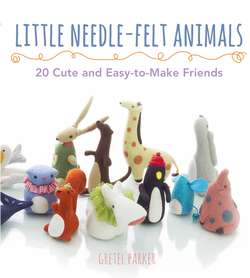Читать книгу Little Needle-felt Animals - Gretel Parker - Страница 15
ОглавлениеMake sure you have all the tools and materials you need before you get started with needle-felting. With each pattern I recommend how many needles and what size to use for the best finish, but work with whatever you feel comfortable with.
Wool
You can use any wool to needle-felt – coarser wools stick together more quickly, but I always use merino as it gives me the fine, tight finish I prefer. Roving (or tops, as it is also known) comes in long lengths that are usually about 4cm wide.
The measurements of wool that I give in the patterns are fairly precise, but don’t worry if you are a bit over or under; things usually turn out fine, I’ve found.
Felting Sponges and Mats
Always work on a protective sponge or brush mat, especially when beginning a piece of work. If you try needle-felting on your lap without a mat, you will stab yourself as well as your work, which is very painful! Felting sponges should be firm and tight-grained. If you are unsure whether needle-felting is for you, buy sponge for cheapness. For longevity, though, invest in a felting brush mat, which will last for years. I recommend covering the bristles with a thin, smooth textile covering, otherwise the wool sticks directly to the brush.
Needle Holders
There are all kinds of holders for needles. The one I use all the time is the pen holder because it holds the needles very close together, making it more efficient in matting the wool and better for small projects. Other kinds work well, too, and are preferable to simply holding a needle in your hand, which can cause cramps. The fitting end of all needles is the same (see the needles on the right in the photograph) and fits any holder.
Needles
Needles come in a variety of sizes and shapes: the larger the needle size, the finer it is. They range in size from very thick (size 32) to ultra fine (size 43). The needle stems can be cross-shaped, star-shaped, spiral or triangular (the most popular).
I don’t use many types of needle. The majority of my work is made with one or two size 40 triangular needles, though I also use sizes 42 and even 43 for surface finishing. While it’s tempting to try larger gauge needles for quickness, they are not as effective with fine wools such as merino. The really important thing to remember about any size of felting needle is that they are very sharp, so be careful when you are working! They are also very thin, so if you stab too hard or bend them too far, they will snap.
Extra Tools
I use all kinds of extra bits and pieces when working:
• Pliers for bending wire.
• Wire cutters.
• An awl, for so many things; I could not do without mine. Before adding ears to a head, I drill holes so that the ear sits more deeply in the wool. I also make little eye sockets before sewing in the eyes, so that they sit within the head instead of resting on the surface.
• A variety of needles for stitching.
• Long doll needles for thread jointing.
• Beading needles for sewing on seed beads.
• A pair of fine-tipped tweezers, mostly for picking out rogue-coloured fibres from whatever I’m working on.
• Scissors, small and large: I often use the large ones for shearing the fuzzy haze from my work in the final stages (see here).
Threads
I can never have enough threads, as they are all so useful in their own particular ways. Look out for:
• Gutermann polyester threads, which are strong and useful for tying in eyes.
• Thick waxed cord in various colours for tails.
• Thick black cotton thread for noses.
• Sturdy cottons, which are good for thread jointing.
• Coarser linen threads, which are nice for simple rustic pattern stitching.
• Standard embroidery floss, pure silk threads and the vibrant cotton ‘Flower’ threads are all also great for a variety of decorative stitching.
• And my favourite, Anchor Pearl Cotton, has so many gorgeous colours for stylish embroidery and for making beautiful cords for dangles.
Beads and Findings
I like to have as wide a variety of beads as possible. On my larger pieces I usually use the traditional looped black ‘English’ glass eyes. They range in size from the very tiny (2mm) upwards, but black glass seed beads also make good eyes and I often use them on smaller projects. Jewellery findings, such as clips, dangles, brooches, or hat pins, are useful for adding different ways to use your creations.
